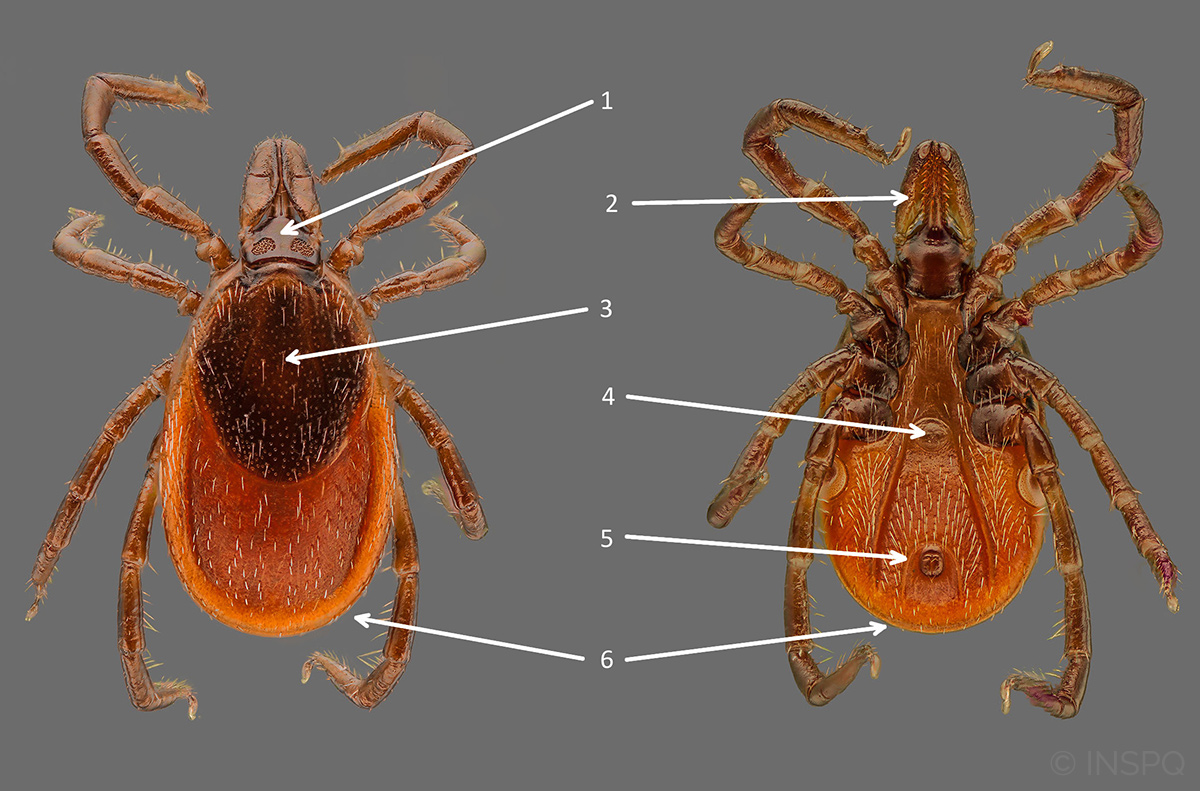Detailed description of the Ixodes scapularis, or black-legged tick or deer tick
Clinical considerations
Ixodes scapularis is a vector of Borrelia burgdorferi (Lyme disease in french), of Anaplasma phagocytophilum (anaplasmosis), of Babesia microti (babesiosis), of Powassan virus (Powassan encephalitis), of Borrelia miyamotoi and of the newly described Ehrlichia muris-like agent.
Geographical distribution
The INSPQ has produced a map showing the risk of acquiring Lyme disease (in french), which shows the places where black-legged ticks are found. This map is updated annually using the data collected through the Programme de surveillance intégrée de la maladie de Lyme (Integrated Lyme disease surveillance program).
Morphological characteristics
Ixodes scapularis in the female stage
Dorsal surface and ventral surface of the Ixodes scapularis tick in the female stage.
Head
1- Basis capituli rectangular
2- Long palps (palps are longer than the basis capituli)
 Abdomen
Abdomen
3- Partial shield, oval, dark and inornate (uniform colour – without light spots)
Absence of eyes (see Positioning of eyes)
4- Presence of genital pore
5- Anal groove above the anus
6- Absence of festoons (see Morphological criteria), unlike ticks belonging to other genera (Dermacentor, Amblyomma, Rhipicephalus and Haemaphysalis)
Ixodes scapularis in the male stage
Dorsal surface and ventral surface of the Ixodes scapularis tick in the male stage.
Head
1- Basis capituli rectangular
2- Short palps
Abdomen
3- Complete shield, inornate (uniform colour – without light spots)
Absence of eyes
4- Presence of genital pore
5- Anal groove above the anusAbsence of festoons, unlike ticks belonging to other genera (Dermacentor, Amblyomma, Rhipicephalus and Haemaphysalis)
Did you know?
Males belonging to the family of hard ticks cannot become engorged during a blood meal. In fact, their rigid, complete shield does not allow them to expand. Males are rarely responsible for the transmission of Lyme disease since they do not remain attached long enough.
Ixodes scapularis in the nymph stage
Dorsal surface and ventral surface of the Ixodes scapularis tick in the nymph stage.
Head
1- Basis capituli rectangular
2- Long palps (palps are longer than the basis capituli)
Abdomen
3- Oval shield, inornate (uniform colour – without light spots)
Absence of eyes
4- The nymph stage differs from the female stage by the absence of a genital pore
5- Anal groove above the anus
6- Absence of festoons, unlike ticks belonging to other genera (Dermacentor, Amblyomma, Rhipicephalus and Haemaphysalis)
Did you know?
Cases of Lyme disease are generally acquired through the bite of Ixodes scapularis in the nymph stage. In fact, the nymphs are small and usually remain attached longer (≥ 36 hours) before being detected and removed. How long a tick is attached plays an important role in the transmission of Lyme disease: in general, a tick must remain attached to its host for at least 36 hours before transmitting the bacteria. In addition, nymphs are active in the summer, a time of year when people engage in more outdoor activities without necessarily wearing clothing that covers them (long sleeves and long pants).
Ixodes scapularis in the larval stage
Dorsal surface and ventral surface of the Ixodes scapularis tick in the larval stage.
Head
1. Basis capituli rectangular
2. Long palps (palps are longer than the basis capituli)
Abdomen
3. Oval shield, unornamented (uniform colour – without light spots)
Absence of eyes
4. The larval stage differs from other stages in that the larva has only 3 pairs of legs and not 4 like all the remaining stages
Presence of only 3 pairs of legs
5. Anal groove above the anus
6. Absence of festoons, unlike ticks belonging to other genera (Dermacentor, Amblyomma, Rhipicephalus and Haemaphysalis)
Did you know?
Ixodes scapularis larvae do not usually bite humans. In fact, their preferred hosts are a lot smaller and tend to be small rodents and birds. Larvae are unable to transmit the bacteria responsible for Lyme disease during their blood meal.







